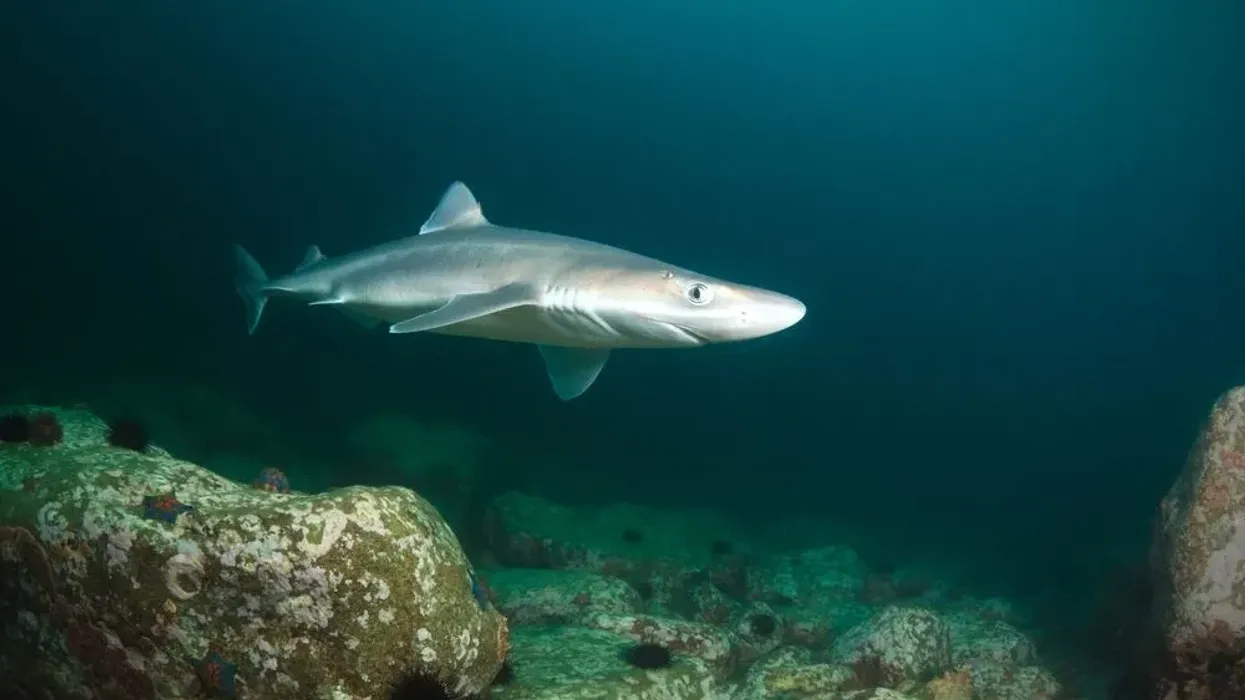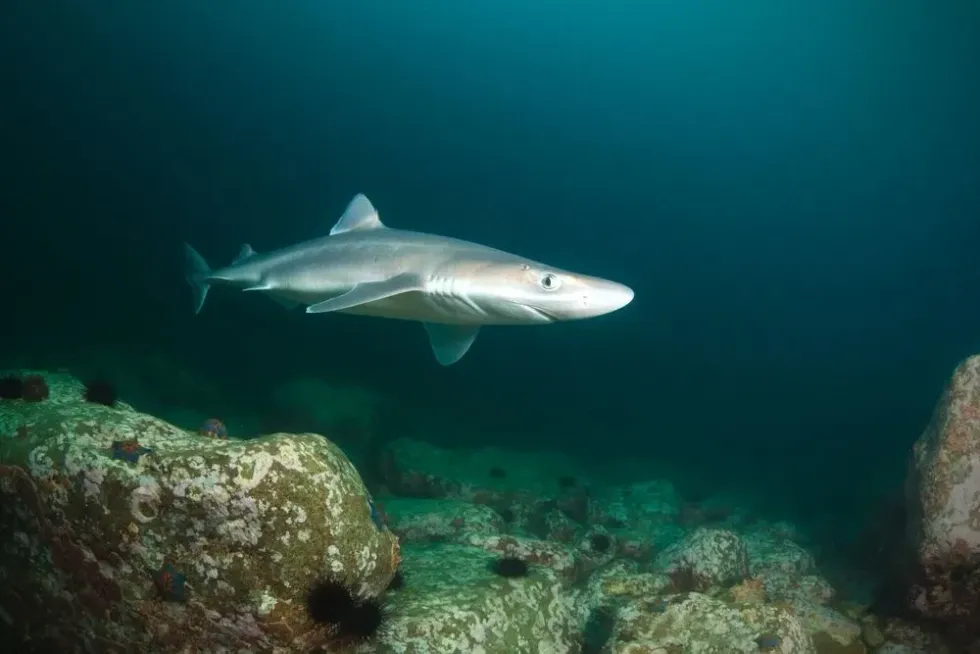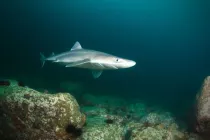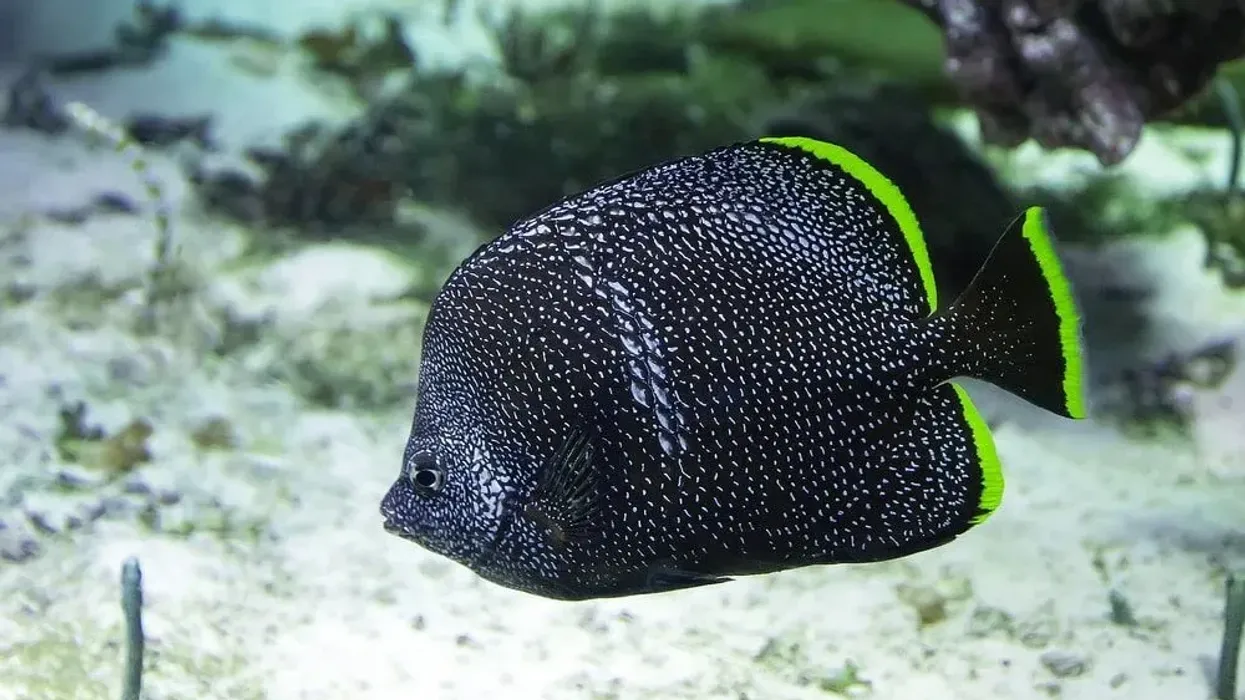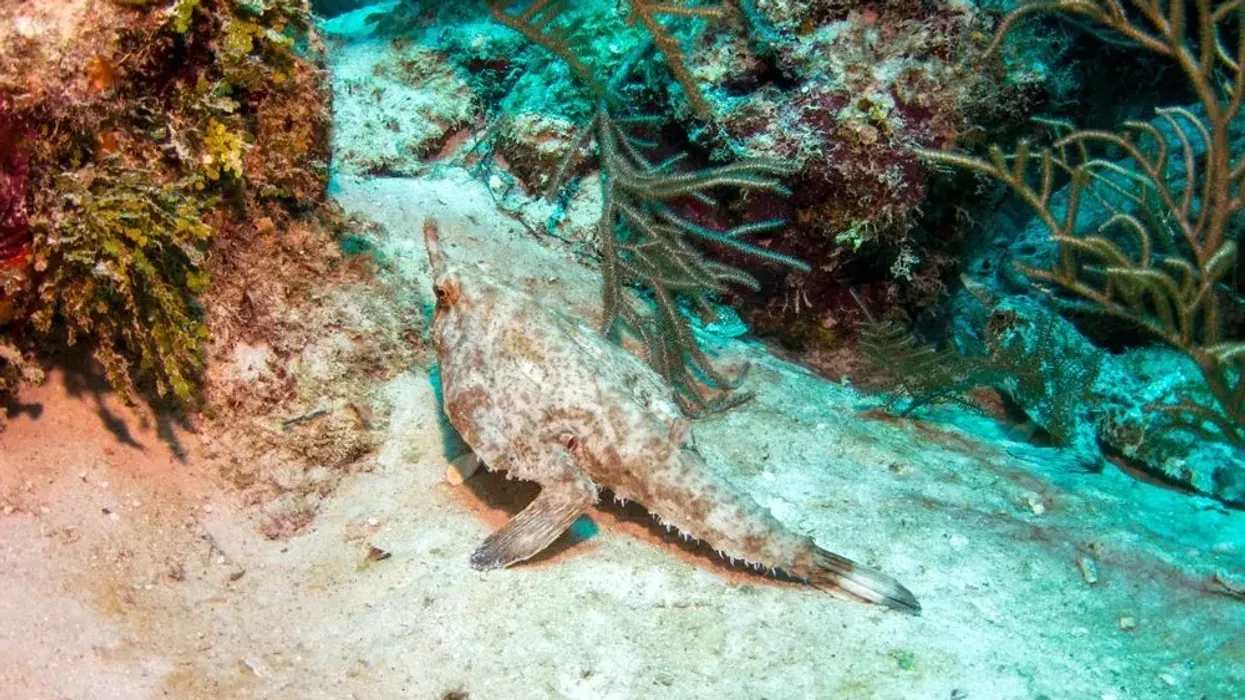Fun Spiny Dogfish Facts For Kids

Content
- What type of animal is a spiny dogfish?
- What class of animal does a spiny dogfish belong to?
- How many spiny dogfish are there in the world?
- Where does a spiny dogfish shark live?
- What is a spiny dogfish's habitat?
- Who do spiny dogfish live with?
- How long does a spiny dogfish shark live?
- How do they reproduce?
- What is their conservation status?
- What do spiny dogfish sharks look like?
- How cute are they?
- How do they communicate?
- How big is a spiny dogfish?
- How fast can a spiny dogfish swim?
- How much does a spiny dogfish weigh?
- What are their male and female names of the species?
- What would you call a baby spiny dogfish?
- What do they eat?
- Are they dangerous?
- Would they make a good pet?
- Did you know...
- Can you eat spiny dogfish?
- Smooth dogfish vs. spiny dogfish
The spiny dogfish belongs to the shark species and derives its name from the fact that it has spines visible next to its two dorsal fins. These spines are helpful for these little sharks as they allow them to shoot venom at their predators when attacked.
They are known to hunt in huge packs and are also known by various other names like dogfish shark, piked dogfish, and even spiky dog!
These little sharks are found mostly in saltwater habitats and are abundantly found in the North Pacific and the North Atlantic oceans. Based on their origin, they can be called the Pacific spiny dogfish or the Atlantic spiny dogfish.
The spiny dogfish shark species possess very large eyes and have pointed snouts. For the spiny dogfish, Squalus acanthias is its scientific name. Spiny dogfish have also become popular in the culinary world, particularly in European countries, where their mild flavor makes them well-liked amongst connoisseurs of good food.
To learn more about the spiny dogfish, why not read these facts about the spiny dogfish shark, and check out our guides to the Caribbean reef shark and Porbeagle shark too?
Spiny Dogfish Interesting Facts
What type of animal is a spiny dogfish?
Spiny dogfish are a subspecies of the shark family. They are known as dogfish due to their nature of hunting in packs. They have very distinct white spots on their body and have a pointed snout.
They also have two dorsal fins. Each dorsal fin has a unique function, one dorsal fin is used to stabilize the movement of the fish and the second dorsal fin helps by giving thrust to their movement. Although they are comparatively smaller in size than other sharks, they are very aggressive predators.
What class of animal does a spiny dogfish belong to?
Squalus acanthias, the spiny dogfish scientific name, suggests that these small sharks fall under the Squalidae family. The class of this species of dogfish is Chondrichthyes and this term refers to a class of fish that have skeletons made of bone tissues.
The typical spiny dogfish anatomy further classifies this species into the category of jawed vertebrates.
Spiny dogfish teeth are very small, and they have sharp points in each of their teeth which provide a very sharp cutting edge for attacking prey. There are two species of spiny dogfish, namely the Atlantic spiny dogfish and the Pacific spiny dogfish.
How many spiny dogfish are there in the world?
In the Atlantic Ocean, the total biomass of the spiny dogfish is estimated at a range of 106.8 thousand metric tonnes. The numbers are quite different for the Pacific Ocean, where there is estimated to be around 44,660,000 spiny dogfish.
Regulatory authorities like the National Oceanic and Atmospheric Administration Fisheries (NOAA fisheries) and the Atlantic States Marine Fisheries Commission work relentlessly to ensure the species is well protected and conserved.
Where does a spiny dogfish shark live?
Spiny dogfish are ocean dwellers, and they prefer temperate waters. These schools of sharks are commonly found in the waters of the North Atlantic and the North Pacific oceans. They are most commonly found living near the ocean floor or sea bed. Because of this, they are classified as demersal fishes.
What is a spiny dogfish's habitat?
The most common spiny dogfish habitat is the ocean as they thrive in saltwater bodies. They often switch between inshore and offshore waters, swimming around the Continental Shelf, and they are not found in freshwater habitats.
It is possible for these sharks to drift into brackish water though they prefer saltwater surroundings and thrive well under the pH level range of 6.5-8.5. A temperature range of between 42.8-51.8 F (6-11 C) is optimal for their survival.
Who do spiny dogfish live with?
The spiny dogfish lives with its own pack, which generally includes hundreds or thousands of spiny dogfish. They choose to hunt their prey in these huge groups in oceans and sea waters.
They might even wipe out a large area where their prey is available when attacking smaller fish. They also often choose to live in packs of the same size or sex and many fishermen often recount their encounters with these schools of sharks. Due to their pack mentality behavior, fishermen came to call these sharks, dogfish.
How long does a spiny dogfish shark live?
The average lifespan of our small shark friends ranges between 20 and 24 years, but sometimes they can also have a longer lifespan of up to 50 years. The NOAA Fisheries Management controls levels of fishing of these small sharks to ensure the longevity of their survival.
How do they reproduce?
Sexual maturity is attained at 11 years of age for males and 18–21 years of age for females. Spiny dogfish reproduction takes place in the winter months and this reproduction happens through aplacental viviparity.
This means that the embryo grows inside an egg in the mother's womb during the gestation period before it hatches. Their mating occurs in offshore waters during winter. Offshore waters and the cold winter months provide an ambient environment for the reproduction of both the Atlantic spiny dogfish and the Pacific spiny dogfish.
These sharks mate by internal fertilization. After fertilization, a protective layer is formed around the embryo, called a candle.
This layer, the candle, is shed after four to six months whilst the embryo continues to grow inside the female until it is ready to hatch. The gestation period of a spiny dogfish is between 18 to 24 months, one of the longest gestation periods of any vertebrates.
What is their conservation status?
The International Union for Conservation of Nature (IUCN) classifies the population of spiny dogfish as Vulnerable. They are a high-risk category of species that may face extinction due to artificial factors including human interactions and interventions.
Overfishing is just one major threat to the population of this species. There are different schemes in place that are run by the Government to regulate fishing of the spiny dogfish in an attempt to protect the species.
The National Oceanic and Atmospheric Administration Fisheries organization, the Atlantic States Marine Fisheries Commission, and the New England Fishery Management Councils keep control of fishing of spiny dogfish in the North Atlantic and North Pacific oceans.
These regulatory authorities have put together a Fishery Management Plan, which places a cap on the volume of this species that can be caught annually, known as an annual quota.
The Fishery Management Plan keeps a check on how humans use spiny dogfish and aims to maintain the species' population.
Spiny Dogfish Fun Facts
What do spiny dogfish sharks look like?
These spiked dogfish have a very lean, smooth body, and they are characterized by the presence of two spines next to their two dorsal fins. Their spines offer a good level of protection from predators.
When attacked, spiny dogfish arch their bodies and attack their predators using these spines, through which they inject their venom. The size of this species is small compared to other sharks found on the seafloor and this shark species sports white spots on its sides and doesn't have an anal fin.
Their white spots generally disappear as the sharks mature.
The top of their body is mostly brown or grey, and the belly side is a much lighter shade of white. Their large eyes really stand out in their appearance.
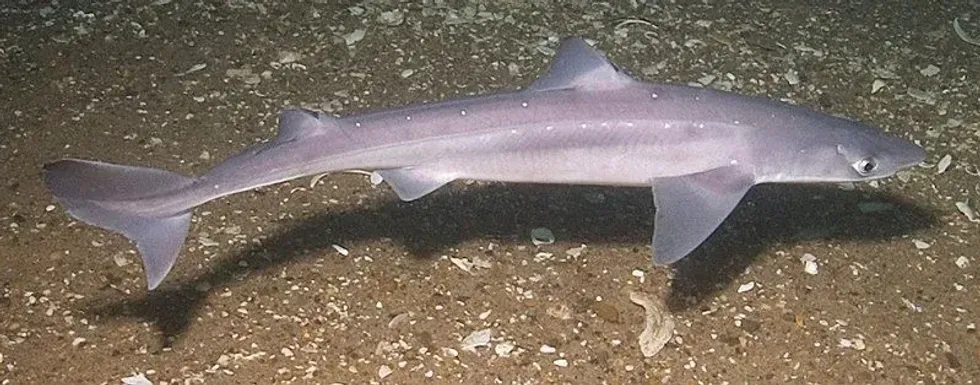
How cute are they?
Anyone who has heard the famous 'Baby Shark' song will definitely agree that, for kids and adults alike, these creatures of the sea are an interesting and exciting subject. Given their smooth body and sharp features with white spots along their sides, these amazing animals are a subject of wonder, even if they are aggressive and ferocious in nature.
How do they communicate?
They show a pack's mentality and behavior, meaning that they can be found in large groups, among whom they regularly communicate. Whether they need to target their prey in their hunting grounds, or overcome the hurdles of being targeted by fishermen, they work together.
They form very large schools based on size and sex and can provide a lot of resistance to fishermen when needed.
How big is a spiny dogfish?
The average spiny dogfish size is small compared to many other fish in the shark family. These sharks can grow up to 39 in (99 cm) as males and 49 in (124 cm) as females.
This is much smaller than the smooth dogfish that can grow up to 59 in (150 cm) long.
The females of the species are longer than the males, and, unlike the sandshark, dogfish sharks do not pose a great threat to humans. In fact, human actions have harmed spiny dogfish historically as owing to their small size they often end up as bycatch during the fishing process.
How fast can a spiny dogfish swim?
These spiny dogfish are very fast swimmers. They can swim for long lengths of sea waters and ocean waters. Records have shown the spiny dogfish is able to swim at about 6.2 ft/s (1.9 m/s).
As well as their speed, fishermen often recount the notorious aggressive nature of these brutish animals as they almost rip apart fishing equipment and nets when they are caught. They swim fast in the sea with so much force that they can even damage fishing equipment!
How much does a spiny dogfish weigh?
The average weight of a spiny dogfish is 8 lb (3.6 kg) but they have been known to weigh as much as 22 lb (10 kg). Female spiny dogfish are normally larger than males of the species.
What are their male and female names of the species?
There is no specific name for males and females of this species, but they are anatomically distinguished by the fact that the male sharks have claspers and females have ovaries. Also, generally, females of this species are larger than their male counterparts.
What would you call a baby spiny dogfish?
The babies of spiny dogfish are called spiny dogfish pups. It is fascinating to note that after giving birth to their pups, these sharks do not care for them. The pups are strong and aggressive predators right from birth.
What do they eat?
They are omnivorous animals, so a typical spiny dogfish diet will include small fish like herring, cod, and catfish. They also eat squids, octopi, and jellyfish.
Their general nature is to hunt on whatever is available in their immediate surroundings hence they are known as opportunistic feeders. They eat small amounts during the winter months and they have to move towards warmer coasts where their prey will be abundant during the summer months.
Are they dangerous?
Spiny dogfish are very aggressive and they are dangerous predators in the animal kingdom. The two spines of these fishes are used to attack their own predators.
Spiny dogfish poison or venom is injected through their dorsal fins into their attackers when they feel threatened.
This species of sharks forms large packs to attack large areas in their vicinity, where their prey (including lots of small fishes) are found in abundance. The shark pups of spiny dogfish can attack creatures two to three times larger than their own size, making them vicious predators from birth!
Would they make a good pet?
No, these predators are better left in their natural habitat, the ocean. As they live in packs, hunt with their school of sharks, and can be very aggressive, it is impossible to keep such dangerous animals as a pet and this should not be attempted.
They require specialized care if kept in captivity so, other than in the wild, you might be able to see spiny dogfish at some aquariums. Have you ever seen a spiny dogfish?
Did you know...
The Atlantic spiny dogfish and the Pacific spiny dogfish both use their pointed snouts to ram into their prey and attack it.
These dogfish sharks have a special organ called the 'Ampullae of Lorenzini' which they use to detect the electric field generated by their prey. Their sense of smell is also quite strong and two-thirds of their brain provides and works for its sense of smell.
Spiny dogfish are extensive travelers and they are known to swim very long distances in the ocean and sea waters. some researchers have recorded instances where these sharks have traveled almost 5000 miles (8047 km) in distance.
As previously mentioned, spiny dogfish have one of the longest gestation periods of any vertebrates. This means that female spiny dogfish can sometimes carry their young for up to 24 months! The length of this gestation period further exposes this species to external threats of extinction.
Can you eat spiny dogfish?
Yes, they are very much edible and are enjoyed for their mild and sweet flavored meat. Eating spiny dogfish is common in many countries, including China, France, Germany, and Italy.
Fin needles are one popular spiny dogfish recipe in China and other recipes that are popular include pan-seared spiny dogfish, and even spiny dogfish tacos!
Due to the lean nature of spiny dogfish, their meat tastes best when grilled or fried with the right amount of herbs. They are a wonderful choice of seafood for food lovers, have you ever eaten spiny dogfish meat?
Smooth dogfish vs. spiny dogfish
Spiny dogfish aren't the only dogfish found in our oceans, they have a cousin called the smooth dogfish and there are many similarities and differences between these two species of dogfish.
The major difference between smooth and spiny dogfish is that the smooth dogfish does not have dorsal spines like the spiny dogfish does, which has two spines along with its dorsal fins.
The smooth dogfish has an anal fin while the spiny dogfish lacks one.
There is also a difference in their respective snouts, as the smooth dogfish sports a blunt snout, and the spiny dogfish has a pointed snout. For a spiny dogfish, Squalus acanthias is its scientific name, whereas the smooth dogfish is called Mustelus canis.
Here at Kidadl, we have carefully created lots of interesting family-friendly animal facts for everyone to discover! Learn more about some other mammals including the pumpkinseed sunfish, or longhorn cowfish.
You can even occupy yourself at home by drawing one on our Spiny Dogfish coloring pages.
We Want Your Photos!
More for You
See All
Doctorate specializing in Veterinary Medicine

Oluniyi AkandeDoctorate specializing in Veterinary Medicine
With an accomplished background as a Veterinarian, SEO content writer, and public speaker, Oluniyi brings a wealth of skills and experience to his work. Holding a Doctor of Veterinary Medicine degree from the University of Ibadan, he provides exceptional consulting services to pet owners, animal farms, and agricultural establishments. Oluniyi's impressive writing career spans over five years, during which he has produced over 5000 high-quality short- and long-form pieces of content. His versatility shines through as he tackles a diverse array of topics, including pets, real estate, sports, games, technology, landscaping, healthcare, cosmetics, personal loans, debt management, construction, and agriculture.
Bachelor of Arts specializing in Political Science and Sociology

Spandana KantamBachelor of Arts specializing in Political Science and Sociology
Spandana holds a Bachelor's degree in Political Science from Acharya Nagarjuna University. She has a passion for writing and enjoys reading crime and thriller novels while listening to RnB music in her free time.
Disclaimer
1) Kidadl is independent and to make our service free to you the reader we are supported by advertising. We hope you love our recommendations for products and services! What we suggest is selected independently by the Kidadl team. If you purchase using the Buy Now button we may earn a small commission. This does not influence our choices. Prices are correct and items are available at the time the article was published but we cannot guarantee that on the time of reading. Please note that Kidadl is a participant in the Amazon Services LLC Associates Program, an affiliate advertising program designed to provide a means for sites to earn advertising fees by advertising and linking to Amazon. We also link to other websites, but are not responsible for their content.
2) At Kidadl, we strive to recommend the very best activities and events. We will always aim to give you accurate information at the date of publication - however, information does change, so it’s important you do your own research, double-check and make the decision that is right for your family. We recognise that not all activities and ideas are appropriate for all children and families or in all circumstances. Our recommended activities are based on age but these are a guide. We recommend that these ideas are used as inspiration, that ideas are undertaken with appropriate adult supervision, and that each adult uses their own discretion and knowledge of their children to consider the safety and suitability. Kidadl cannot accept liability for the execution of these ideas, and parental supervision is advised at all times, as safety is paramount. Anyone using the information provided by Kidadl does so at their own risk and we can not accept liability if things go wrong.
3) Because we are an educational resource, we have quotes and facts about a range of historical and modern figures. We do not endorse the actions of or rhetoric of all the people included in these collections, but we think they are important for growing minds to learn about under the guidance of parents or guardians.
